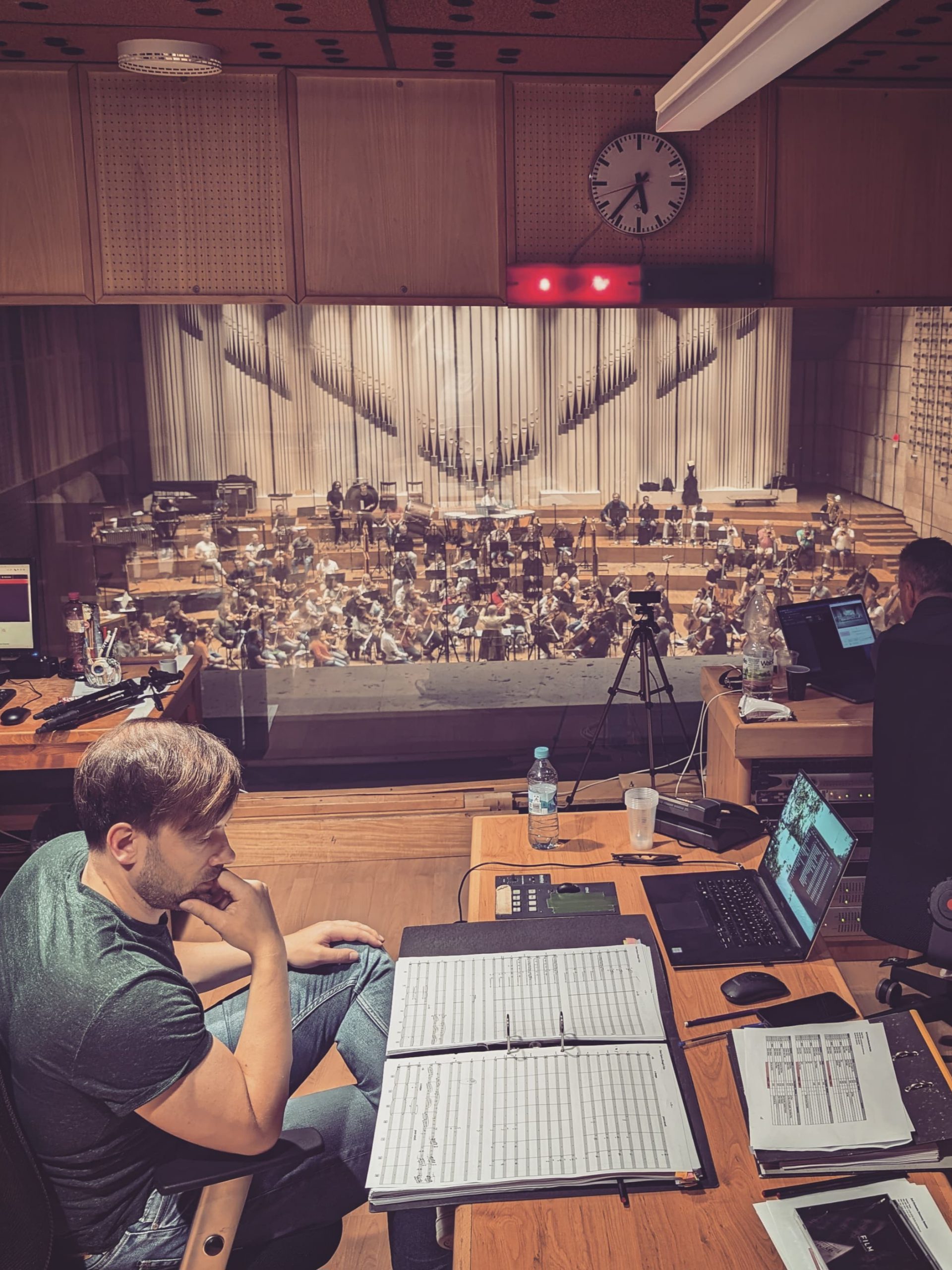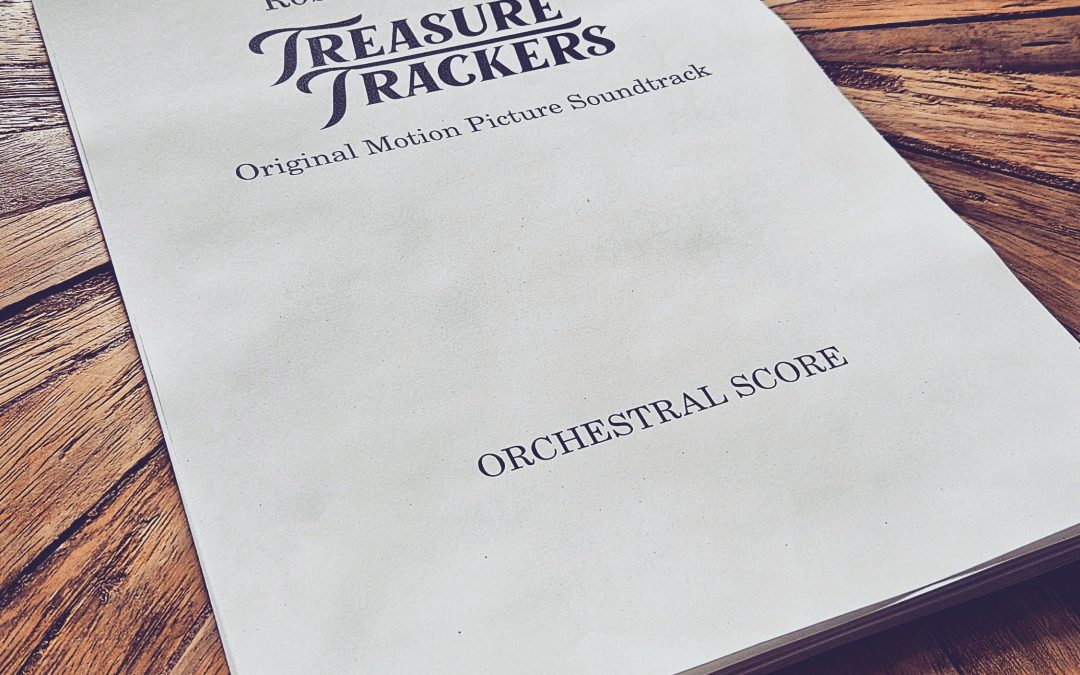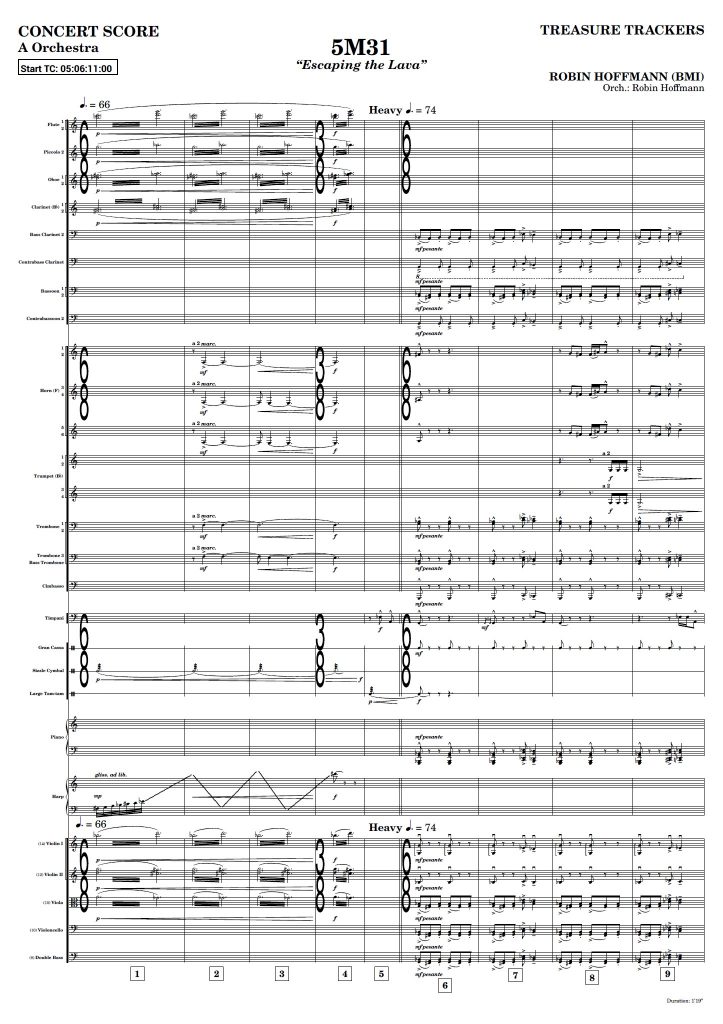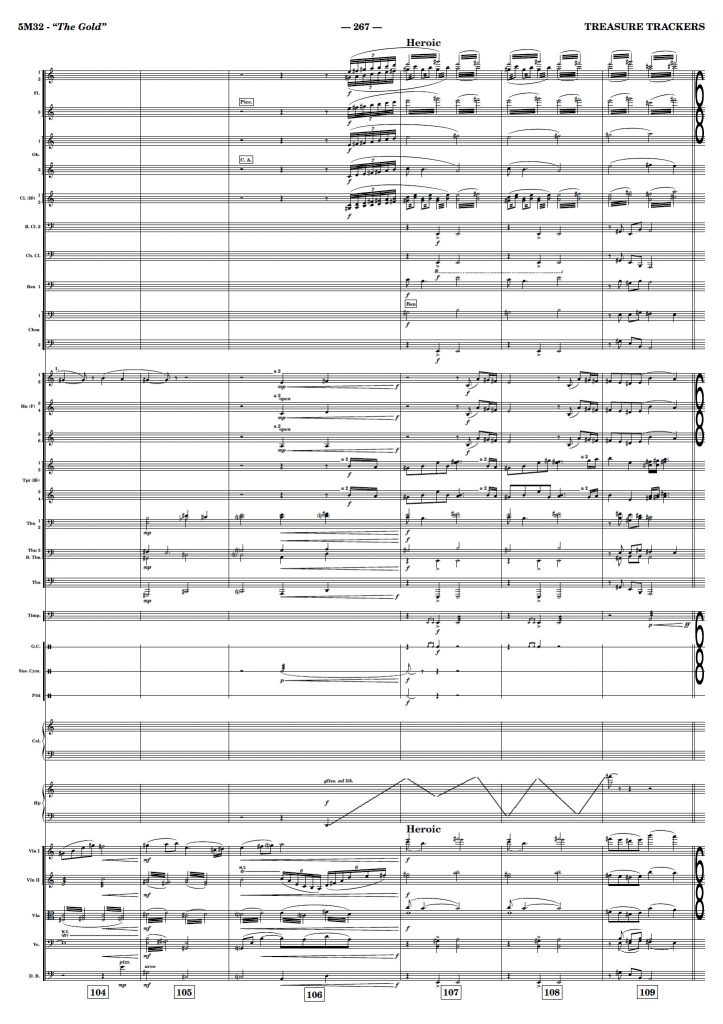Robin Hoffmann is an acclaimed composer with over 20 years of experience, specializing in projects with live orchestras. His work includes internationally recognized film scores, such as the Golden Globe 2024 nominee Suzume and Star Wars Visions, as well as orchestrations for video game music like Batman: Arkham Shadow, Pixar’s Kinect Rush, and more. In this interview, Robin shares insights into scoring Treasure Trackers, a family-friendly adventure film with a Halloween twist, where he skilfully blends nostalgic 80s/90s orchestral influences with modern techniques. He also shares insights into his creative process with Dorico music notation software, describing it as an essential tool for managing the detailed orchestration and complex notation of the 76-minute, nearly 300-page score. Keep reading to learn more!
![]()
AN: Hi Robin, could you share the creative inspiration behind the score for Treasure Trackers? How did you approach blending a classic 80s/90s Hollywood vibe with your unique compositional voice?
RH: The directors, Drew and Nate Garcia, and I had a very clear idea from the onset of working on this movie of what both the movie and music should feel like. We wanted to evoke nostalgia for the films we grew up with as kids and transfer that feeling into today’s time. Composers like John Williams, Bruce Broughton, Alan Silvestri, Jerry Goldsmith, and all the other big names from that era heavily influenced the style of the score.
However, this approach also required recording the score in a very specific way. Unlike the common practice in film scoring today—where additional synths and samples are layered into the music mix, and orchestras are recorded in sections to achieve that modern Hollywood sound—I wanted to record all 90 musicians of the Bratislava Symphony Orchestra at the same time, in the same room, without any additional elements. Essentially, what you hear in the final release is exactly what you would have heard in the hall during the recording. This traditional approach to recording naturally created a distinctive orchestral sound, giving the music that classic vibe.
Personally, I aimed to clearly reference those iconic scores while also incorporating a few more modern musical techniques, along with some of my own musical preferences.
AN: You mentioned that you composed the entire 76-minute score in Dorico music notation software. Could you walk us through your workflow in Dorico? How did the software support your creative process, particularly for such a detailed and colourful score?
RH: With the movie being a relatively small scale production, we quite quickly ran into the issue of budget constraints. Fortunately, the directors were incredibly supportive of the music and took on extra tasks during the filmmaking process to ensure there would be enough budget left for the score, for which I’m extremely thankful. However, even with this tremendous dedication from their side, we knew from the start that it was going to be a tight squeeze. As a result, I had to become a one-stop shop for the music, handling almost everything up to the point where I delivered PDF files to the orchestra myself.
Thankfully, I’m quite experienced in orchestration, having done it extensively for other composers over the past 20 years, so it wasn’t too much of a technical stretch for me. However, the time and budget constraints were very real on this project. I couldn’t have managed without Dorico. My workflow is quite old-school; I always start directly in Dorico. But being responsible not just for composing, but also for orchestrating and preparing parts, was a massive task—one that I couldn’t have completed in my previous notation software within the given time frame.
The time and budget constraints were very real on this project. I couldn’t have managed without Dorico. My workflow is quite old-school; I always start directly in Dorico. But being responsible not just for composing, but also for orchestrating and preparing parts, was a massive task—one that I couldn’t have completed in my previous notation software within the given time frame.
With Dorico, I work with a highly customized personal template that I’ve fine-tuned to my needs over the past five years, since I started using the software almost exclusively. The customization options in Dorico allowed me to write and deliver this much music in just a few weeks. The incredibly powerful input features (like the Shift+I popup, which doesn’t get the attention it deserves!) helped me translate my musical ideas onto the page in a very streamlined way. Not only that, but while it would have taken me weeks to orchestrate and lay out the parts for such a large project in my previous software, in Dorico it took me about two days to finalize the layout and prepare parts for the entire 76-minute score—almost 300 pages of music. This allowed me to send out all the materials to the orchestra with even a few days to spare. The experience of relying on Dorico in such a tight-budget, tight-deadline situation was truly fantastic.
While it would have taken me weeks to orchestrate and lay out the parts for such a large project in my previous software, in Dorico it took me about two days to finalize the layout and prepare parts for the entire 76-minute score—almost 300 pages of music. This allowed me to send out all the materials to the orchestra with even a few days to spare. The experience of relying on Dorico in such a tight-budget, tight-deadline situation was truly fantastic.
An excerpt of the score, #MadeWithDorico
AN: Your score includes some intriguing elements like box notation and aleatoric techniques. Could you share more about your decision to incorporate these? What role do these techniques play in shaping the overall sound and structure of the piece?
RH: While the movie is a family-friendly adventure film, it is also a Halloween movie that touches on some darker themes and includes a few scarier scenes. The music follows suit, becoming quite dissonant at times with traces of more contemporary techniques. With a 90-piece orchestra at my disposal, I knew I wanted to create sounds that could never be achieved with samples alone. Aleatoric elements and box notation were particularly helpful in creating eerie, darker textures. I used a lot of randomized chord sparkles, low rumbling string textures, and high woodwind chatter to give the music an appropriate Halloween-like atmosphere.
As with most film scoring gigs, the biggest challenge is always timeline. There’s never enough time to work out the details as much as you’d like. Any workflow improvement that reduces the time it takes to get ideas onto the page is invaluable, and this is where I feel Dorico truly shines.
AN: What were some of the challenges you encountered when working on this score, especially with the detailed and intricate orchestration? How did Dorico help you overcome these challenges?
RH: As with most film scoring gigs, the biggest challenge is always timeline. There’s never enough time to work out the details as much as you’d like. Any workflow improvement that reduces the time it takes to get ideas onto the page is invaluable, and this is where I feel Dorico truly shines. Creative operations—like horizontally moving a line and having Dorico automatically re-notate the rhythm to match standard conventions—are major time savers. In my previous notation software, cleaning that up would have taken several minutes.
The biggest efficiency gains, however, come from frequently used operations. Every second saved on these tasks adds up to huge time savings. With that in mind, I find the Jump Bar to be an absolutely ingenious tool. The few seconds I save each time by invoking it and quickly accessing the command I need, instead of clicking through menus or trying to remember shortcuts for more obscure operations, is a massive cumulative time saver. When combined with a Stream Deck and the Dorico templates from Notation Central, it becomes unbeatable team for speed.
I’d say I used to be a power user in my previous notation software, but with Dorico, I’m at least twice as fast in generating playable output as I ever was before.
AN: Given that the score was recorded with a live orchestra, how did Dorico facilitate the preparation of the score and parts for recording sessions? Were there any specific tools or functions in Dorico that proved particularly useful during this stage?
RH: The way Dorico automatically handles most of the part layout is a huge time saver. If you’ve set up your page templates and settings properly, there’s barely any additional work needed to optimize the parts. Most of the time, I’m just scrolling through the parts, adding manual page or system breaks when necessary—but that’s usually it. Another major benefit, especially for an orchestra of 90 musicians, is the condensing feature. To avoid overcrowding the score with too many staves, which can make them too small to read, condensing is essential. Dorico’s mostly automatic handling of this process is another huge time saver. I remember how much time it used to take me to manage this issue before I started using Dorico.
During the session, I spoke with the conductor, David Hernando Rico, and he mentioned that, typically, the musicians don’t say much during sessions and focus on the recording. However, in this case, they were constantly commenting on how great their parts looked and how much fun they were to play from. It can’t be stressed enough how important good-quality sheet music is for an orchestra—it has a huge psychological impact. Dorico played a big role in why the recording sessions went as smoothly as they did.

Composer Robin Hoffmann in action during the Treasure Trackers recording session with the musicians of the Bratislava Symphony Orchestra.
AN: You have released the entire score sheets for study as a free PDF download. What inspired this decision, and how do you hope it will benefit other composers and musicians? Did Dorico’s engraving and exporting capabilities influence your decision?
RH: I still remember being a teenager, falling in love with film music but having no access to score sheets to study the music I loved in depth. All I had were the recordings, and that was it. I couldn’t figure out how things were done or even identify which instruments were playing in the combinations I heard. Reflecting on my younger self, I would have greatly appreciated the opportunity to access score sheets and study them. Fortunately, times have changed, and it’s now easier to get access to film score sheets, but it often still requires a financial investment that can be steep for someone just starting out.
Additionally, orchestral music continues to struggle to attract younger audiences and is constantly under threat of budget cuts in many countries. If I can play even a small role in sparking excitement and love for orchestral music in a new generation—and opening up this world to them by creating music that is more accessible than diving straight into the major works of the classical literature—then I feel like I’ve accomplished my mission. Giving them the chance to explore what’s going on in the music by making the score sheets available is one of the keys to keeping orchestral music alive for future generations. Of course, Dorico has played a big role in this as well, effortlessly creating ready-to-print score sheets that are clear and easy to read.
AN: As you continue to work on various projects, how do you see Dorico fitting into your future work? Are there any features or updates you’re particularly excited about that would enhance your compositional and orchestration process?
RH:I love the direction Dorico has taken in becoming a one-stop shop for creating not only great notation but also presentable audio demos. In the film scoring world, demos often need to be highly polished and sound great. Working in notation software first typically means exporting MIDI and manually crafting a convincing mock-up in a DAW afterward. I appreciate how Dorico has begun to challenge this necessity. In fact, for Treasure Trackers, with the level of mutual trust between the directors and me, the audio demos from Dorico were already sufficient for them. However, not all composer-director relationships have that same level of trust.
I’m excited to see future developments in this area and hope that one day, I’ll be able to achieve the same mock-up quality by simply pressing play in Dorico that I currently get from manually crafting a high-quality mock-up in a DAW.
AN: Thank you for sharing these with our audience, Robin. Wishing you all the best with Treasure Trackers and your upcoming projects!
🎶 Enjoy the full score of Treasure Trackers: Robin Hoffmann – Treasure Trackers – Original Motion Picture Soundtrack – CONCERT SCORE
🎧 Listen to the Treasure Trackers Soundtrack
To explore all streaming and purchase options for the Treasure Trackers soundtrack, visit: album.link/treasuretrackers.
🎬 Check out the official trailer for Treasure Trackers below!




Propuesta para Crearmusica2.
Hola, encantada de saludarte.
Quería escribirte porque me ha parecido interesante comentar contigo la posibilidad de que Crearmusica2 aparezca cada mes en periódicos digitales como noticia para posicionar en los primeros lugares de internet, es decir, con artículos reales dentro del periódico que no se marcan como publicidad y que no se borran.
La noticia es publicada por más de cuarenta periódicos de gran autoridad para mejorar el posicionamiento de tu web y la reputación.
¿Podrías facilitarme un teléfono para ofrecerte un mes gratuito?
Gracias.
Nice work – I found that very interesting.
I created my re-score of the Disney short animation “Paperman” (https://youtu.be/9APSHN8SOsw) in exactly the same way – straight from Dorico.
James